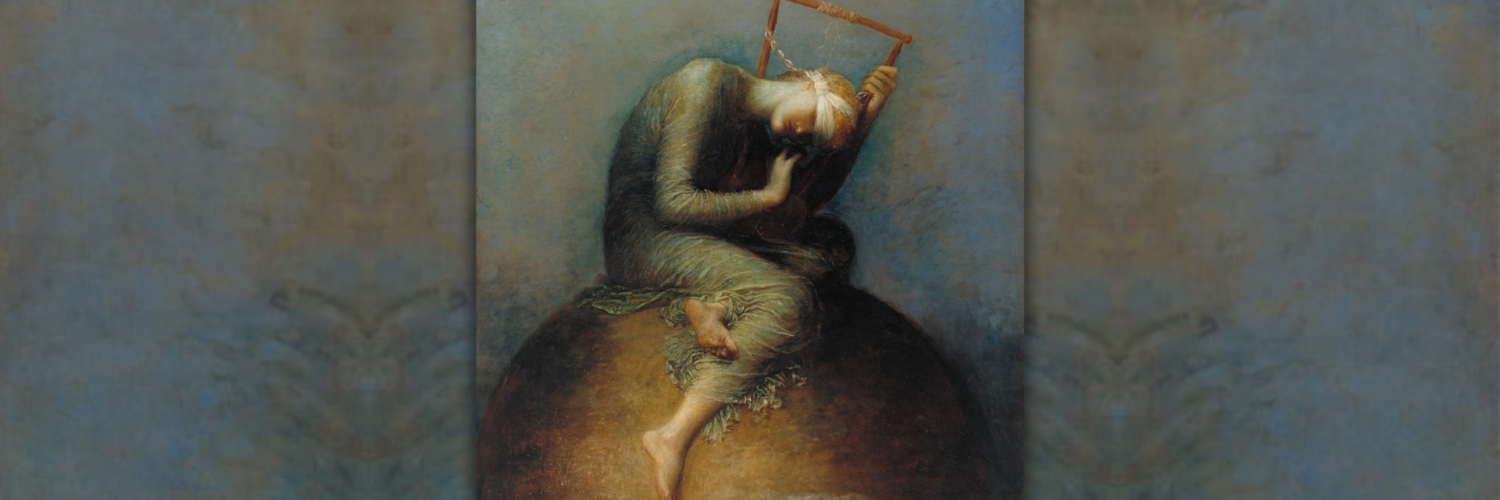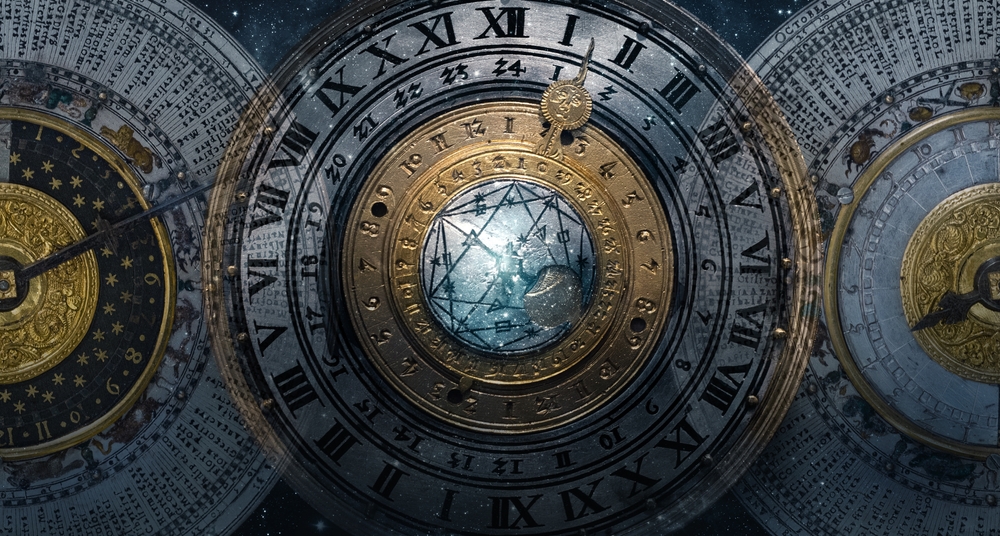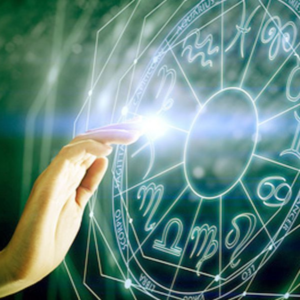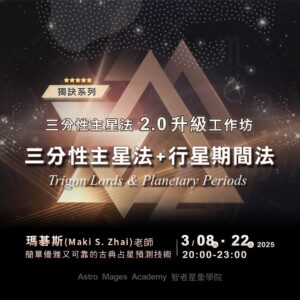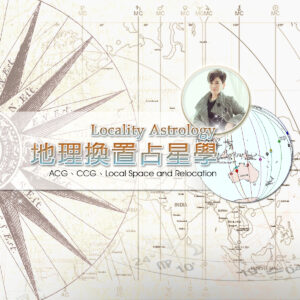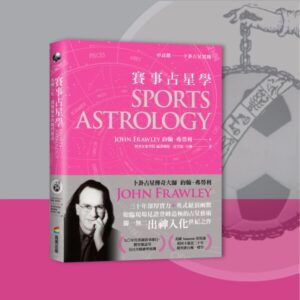發布日期:2023年09月08日
本文經作者授權已翻譯成越南語,現授予智者星象學院翻譯並刊登中文版
本命星盤能為「慢性抑鬱症」於精神病學的診斷帶來什麼啟發?
在美國街頭普遍以行話「藍調」(the blues)來暗稱慢性抑鬱症(Chronic Depression)或「輕鬱症」(dysthymia),其特徵是長期處於悲傷並感覺疲勞。患者無法隨意改變自己的情緒,可能多年持續地沈浸在悲傷、絕望、內疚、後悔和自殺的念頭。發作時會感到深沉的冷漠,覺得人生毫無樂趣可言。可能還有食慾或體重的變化,睡眠過多是典型的症狀,或另一種的表現為失眠。發作時間可能持續數週至數年,且反覆發作。這並非因為悲傷、藥物或情境壓力而引發的狀態。
許多長期抑鬱的患者會經歷暫時性的、其性質更為嚴重的發作,稱為「重度抑鬱症」(Major Depression);二者併發稱為「雙重憂鬱症」(double depression)。就本篇探討的目的而言,會將慢性與重度抑鬱症的整體範圍統稱為慢性抑鬱症。
作為占星師,我們可能假設,是的,誕生星盤能夠揭示導致抑鬱的過度占星能量。本文與我的三個案例研究,即為考察慢性抑鬱症之行星與元素的典型「特徵」。
讓我們再提出一個更相關的問題:精神病學能否經由了解其表現,而為長期抑鬱的占星能量學獲益?
畢竟,占星學基於行星和元素能量對於精神疾病的理解,可是比精神病學早了好幾個世紀啊!
目前定義的抑鬱症類型
臨床心理學目前定義九種類型的抑鬱症:慢性抑鬱症;重度抑鬱症;產後憂鬱症(Postpartum Depression);季節型情感障礙症(Seasonal Affective Disorder);非典型憂鬱症(Atypical Depression);精神病性憂鬱症(Psychotic Depression);雙相情緒障礙症(Bipolar Disorder,或稱躁鬱症);情境性焦慮症與經前不悅症(Situational and Premenstrual Dysphoric Disorder)。由於篇幅有限,我們僅討論本研究的唯一焦點──慢性抑鬱症。
抑鬱症的傳統觀點
文藝復興時期的行醫占星師認識並記錄了行星、星座、元素,以及「體液」(humor,身體內的液體)的能量,認為它們是導致抑鬱或「憂鬱症」(melancholia)的原因。在此我們尚有足夠的篇幅對這些觀點進行簡要的調查。必須注意的是,源自星象的影響只是公認的眾多可能原因之一,而研究占星盤則是為了判斷所有可能導致健康不適的不同成因。中世紀和文藝復興時期的醫生完全接受行星的因果關係,將其視為身體和精神之所有類型疾病的主要病因。
傳統認為,所有疾病皆由四種質料(qualitiy)的不平衡而引起:熱、冷、乾、濕1。人們提出各式各樣的原因(包括便祕)來解釋體液為何失衡致病,其中還包含了行星光束(planetary beams)!沒錯,行星會讓你生病。
古代的醫生主要關注溫度和濕度的流動與平衡,認為抑鬱的能量屬於冷/乾,或者是冷/濕。導致抑鬱的占星特徵通常歸類為幾個面向,主要是土星的寒冷效應2-3,包括直接地影響或透過它的星座—摩羯座和水瓶座—發揮作用。康奈爾博士(Dr. H. L. Cornell)的著作 “Encyclopedia of Medical Astrology” 將「憂鬱」(melancholy)以及「病態的精神與身體症狀」編列在土星之下4。這種觀點在古代相當普遍5。
同樣受到責怪的是寒冷、乾燥的「憂鬱體液」(melancholic humor),即身體內黑膽汁(black bile)的液體過量;有時則是寒冷、潮濕的「冷淡體液」(phlegmatic humor)或黏液(phlegm)的過量(下文將有更詳細的說明)。
除了其他幾個已知原因之外,行星能量可能使身體內四種的液體或「體液」失衡,從而引發抑鬱。這可能一出生(本命)就帶有,抑或隨著流運發生。
憂鬱的糊塗帳:為何四元素與四「體液」不應混為一談?
這一小段內容將暫離本文主題,繞道提點一下。占星元素和傳統體液的合併造成了醫學上的混亂,對此一事不感興趣的讀者,可以跳到下面題為「水元素星座與慢性抑鬱症」的那一節;假如你是一名醫學占星師,本段則為必讀內容。
抑鬱症狀的各種「冷淡」類型,可說是水元素星座6(巨蟹座、天蠍座、雙魚座)的典型特徵。然而,儘管土元素星座(金牛座、處女座、摩羯座)的實際特徵與慢性抑鬱症的典型症狀不大相符7,卻變得與抑鬱密切相關。這個難題是如何發生的呢?
「憂鬱」一詞是抑鬱的另一種稱呼,字面意思是「黑色的膽汁」,源於希臘文的 melas「黑色」+khole「膽汁」。人們認為這種身體的體液是造成抑鬱的原因,即過量時會發生「憂鬱病」。(幾個世紀後,關於黑膽汁的研究發現,要麼認為它不存在,不然指的就是時而在血液中發現的棕灰色沉積物,而不是真的膽汁。)
希波克拉底(Hippocrates,西元前四六〇-三七〇年)創立了此一健康相關的四體液學說(four-humor theory),因而現在就有了四種占星元素和四種體液!此外,這四種體液如果過量,就會表現為四種人類生理或心理上的「氣質」(temperament):易怒的(Choleric)、憂鬱的(Melancholic)、樂觀的(Sanguine)、冷淡的(Phlegmatic)。(這些氣質與它們的前身──四種「元素」並不相同。)
四種體液與它們所代表的氣質,依下列方式分配到熱度與濕度:黃膽汁(yellow bile)-易怒:熱/乾;黑膽汁-憂鬱:冷/乾;血液(blood)-樂觀:熱/濕;黏液-冷淡:冷/濕。
如果不去考慮這些組別可能的差異,把四種體液及其四種氣質與最初的四元素相匹配,似乎有種優雅的對稱性。四種氣質分配到傳統四元素的方式如下:易怒-火元素;憂鬱-土元素;樂觀-風元素;冷淡-水元素。但是當各別檢視星座,這個系統就會崩解失效。
剛剛提到體液的「黑膽汁」(即憂鬱氣質),它作為代謝劑(metabolic agent)被指定給了它歷史上的前身—土元素。現在的邏輯就變成,因為黑膽汁「導致」抑鬱,並且屬於土元素,那麼土元素星座本質上一定是抑鬱的(即使水元素星座有更多出了名的特徵最符合慢性抑鬱症的症狀!)
不幸的是,將這四種假定的身體「體液」與「它們的」四種占星元素的錯誤合併,在早期著作中已成標準,以至於完全忘了提及元素本身!
這造成了許多診斷上的混亂,因為二者並不完全相同。例如,水瓶座,隆冬時節由土星主管的星座,一些較早的文獻正確地將其列為「冷」。就星座類型而言,水瓶座很適合成為最寒冷星座的候選者。隆冬時節通常是一年中最冷的時候!
然而四體液學說一出現,就把包括水瓶座在內的所有三個風元素星座,分配給了「樂觀」的體液,因此列為「熱和濕」,也把「開朗」列入,替換掉文本的內容!把水瓶座歸為熱的屬性並不合理,因為這個星座的醫學及氣質特徵都是偏冷的,而不是偏熱的!(水瓶座類型的人以足部冰冷、血液循環不足、抑鬱、貧血、低血壓和靜脈曲張而著名。)
反對將四體液與四元素相提並論的另一個論點是「暖與涼」這些溫度「不見了」。體液學說中,相同元素的星座被分配到歸屬於「它們」的體液,因此必須是「熱」不然就是「冷」。可惜的是,人生並不是這樣一分為二!星座也是如此。
這些星座的變量太多了,不能在極端溫度下依元素將之歸為一類。例如,風元素星座(雙子座、天秤座、水瓶座)都被認為是「熱」的,只因為「它們」的體液(血液)被歸類為熱。從生理與心理檢視,雙子座和水瓶座都不熱;不過我們可能很容易就把溫和的天秤座想像成「溫暖」。典型的天秤座類型正是如此,既不熱也不冷,而是溫暖。天秤座畢竟是象徵平衡的星座!
同樣的難題也適用於體液所劃分的另一半,濕度i:濕/乾。例如,土元素歸類為「乾」,因為它分配到的體液「黑膽汁」被認為是乾的。因此,所有三個土元素星座(金牛座、處女座、摩羯座)現在也必須跟著一起變「乾」!但,它們真是這樣嗎?
很容易引起爭議的是金牛座,我們最肥沃和最有魅力的星座之一,幾乎毫無「乾」可言。金牛座的人也沒有因為他們是土元素星座,就像處女座和摩羯座那樣遭受同樣「乾燥」的病痛折磨。事實上,金牛座的人以他們的光澤秀髮、豐滿嘴唇和性感姿態而著稱。而且,一年之中最繁榮的時期為什麼能量上是「乾」的?它就是對不上!
星座是元素、行星、模式和季節能量的混合體。先理解這一點,我們就很容易注意到,雖然星座被分配其元素的組別,但星座並非元素本身。反過來說,元素不是星座,而且元素也不等同於四種體液。(我的主要觀點!)
對此感到困惑的占星師,最佳建議是使用傳統的四元素(火、土、風、水),不要把它們與後來的四種傳統體液及四種氣質混在一起,直到你清楚認識到其中的深度差異。人們可以直接從誕生星盤診斷出元素失衡,而不需要體檢;但是,體液失衡則必須觀察身體狀態才能確定,這就是它們醫學上的預期用途。
水元素星座與慢性抑鬱症
關於抑鬱症,水元素星座過量時的典型特徵恰恰符合長期抑鬱的症狀,即「憂鬱症」,這遠比講究實際、堅韌、現實的土元素星座更加符合。(就我個人而言,並沒有觀察到多數土元素星座的人出現這種疾病的「嗜睡」症狀。)
然而,雙魚座、巨蟹座和天蠍座的人遭受折磨(而消極)時,確實以呈現出長期抑鬱的所有臨床症狀而著稱:疲勞、內向、悲痛、憂傷、冷漠、沒有生活樂趣、厭惡運動、恐懼、無望、自我厭惡和自殺意念,再加上對睡眠的深切熱愛。水元素星座也是由三個傳統「無聲」星座組成,並自然地與八宮的死亡及十二宮的悲傷相關。哭泣是一種水元素行為!
查爾斯.卡特(Charles E. O. Carter)在其著作 “Encyclopedia of Psychological Astrology” 討論「憂鬱」時寫道6「水元素星座都傾向於情緒化」。隨意瀏覽歷史上的作者們對雙魚座的描述(如果是負面的),就會發現關鍵詞是「敏感」、「抱怨」、「自我否定」、「懶惰」、「放棄」等等。這種名聲是確定的。
雖然有些雙魚座類型的人很開朗,但如果你想學會識別抑鬱的水元素星座類型,可以觀察六位雙魚座名人平時的樣態及聲調:強尼.凱許(Johnny Cash)、拉爾夫.納德(Ralph Nader)、喬治.哈里森(George Harrison)、詹姆士.泰勒(James Taylor)、布萊恩.瓊斯(Brian Jones)和寇特.柯本(Kurt Cobain)。也許我們應該包括比莉.哈樂黛(Billie Holiday)和瑪麗蓮.夢露(Marilyn Monroe),她們慵懶的情緒反映了她們雙魚座的月亮!明白了嗎?(雙魚座、巨蟹座和天蠍座的讀者們請注意,出生在水元素星座並不保證會抑鬱,所有星座都有其獨特的精神困擾!實際上,你們與生俱來的敏感度確實造就了世界上許多偉大的天才。)
約瑟.布拉格雷夫(Joseph Blagrave)在一六五八年對抑鬱狀態的描述(如下),可能是現存早期著作中最具有行為描述性的文獻。他給出了症狀7!
「那些天性憂鬱又發狂的人,通常慣於感到悲傷、嘆息、沉默寡言,少有喜悅感;而那些天性冷淡的瘋癲之人,通常遲緩呆滯,懶惰,除非迫於無奈,否則什麼事都不想做,而且非常喜歡睡覺,如果不被打擾,他們會一起在床上躺個兩三天。」
布拉格雷夫對我們最近分類的九種抑鬱症並不了解,他的評論是基於古老的希臘能量範式,現今已不再流行。我們必須記住,當他談到那些「天性憂鬱」的人時,討論的是一種體液的突出表現,並非土元素星座本身。然而,一旦把土元素星座分配到此一體液,這二者(土元素和憂鬱體液)就變成可以互換了。將「冷淡體液」或淋巴液(lymph)與明顯濕潤的水元素星座互換時也發生了同樣的情況。(易怒體液,即黃膽汁,是分配給火元素,而樂觀體液,即血液,則分配給了風元素)。
就我個人而言,發現除了土星的星座:摩羯座和水瓶座之外,水元素星座(特別是巨蟹座和雙魚座)在表現出慢性抑鬱症狀方面占有主導的地位,其中水元素星座的天蠍座似乎更容易引發較為極端的重度抑鬱症。
相較於富饒的土元素星座可被預期的特徵(即實際、負責、穩定、沉著、努力工作、堅韌),水元素星座過量時的描述則更加符合慢性抑鬱症的症狀。雖說凡有規則必有例外,很明顯地,慢性抑鬱症的症狀像是結合了過量的水元素星座、土星星座,以及下列概述的特定行星特徵。
計算元素:警語
目前用於統計星盤元素的系統有好幾種,以確定元素的主導優勢或不足。然而,如果缺少整合行星與星座的正確知識,很容易就誤入歧途!
例如,如果有張星盤只顯示一顆行星在水元素星座,而這顆行星是土星,我們現在就有了「冰凍」的水。這種狀態對水元素星座不足的星盤沒有幫助。土星壓制火,而你發現土星是唯一一顆在火元素星座的行星時,也必須注意這一點。土星屬於土的性質,在風元素星座強化了土元素,提供一種良好的穩定力量,同時也減緩了它的速度。
而當假設火星這顆炙熱的行星會強化其本命位置的元素能量以前,也必須先了解它的質地。火星會刺激風並使水沸騰!
計算元素時還必須知道的一點是,如何分配權重,或是了解以元素對行星進行計算的重要性。不應將世代共有的外行星設定成與個人行星相同的權重,而且在將小行星的得分加入到你的計分之前,必須使用常識!很顯然地,太陽和月亮這兩顆「發光體」應該得到更多的分數。
寥寥可數的研究
早期占星學在心理健康領域的研究,充其量是稀少的,古代或文藝復興時期的作者僅限於單一案例的評論、對體液學說的討論、附上複雜的特徵列表卻沒有舉例,或者人云亦云引用以前的文本。而這些古代或文藝復興時期的數個案例研究中,據我所知,也少有關於慢性抑鬱症的症狀(或任何其他精神疾病)及其星盤案例的記錄。文藝復興時期的醫生約瑟.布拉格雷夫在其著作中提供了一些病例症狀的簡短記錄。
遺失導致抑鬱症與其他精神疾病的原因(病因學)
對臨床診斷來說,現代西方全盤採用生化醫學模式而遺忘了抑鬱的病因,如能重新考量這一點將可從中獲益。文藝復興時期的醫生考量導致抑鬱的原因,比我們今日所了解的還要廣泛得多,其中包括:便祕、受驚嚇、悲傷事件、巫術、精靈問題8的靈性干擾9、四種體液的不平衡、占星元素或行星射線或二者同時的影響10。如果把過去公認的幾種抑鬱症類型加入今日臨床上的「九大原因」並加以歸納後,就會涵蓋到源自星象影響所引起的抑鬱症!
如果有人接受真的有輪迴(就像大多數印度占星家一樣),那麼對無法解釋的不適症狀來說,未化解的前世記憶即是一個合理來源,這構成了第十類抑鬱症:「前世宿緣」!但現代占星師考慮這些目前不流行的病因倒挺自在。舉個例子,有位朋友分享說,他在六十歲時發現自己長年來想自殺的意念,是由一位自殺的童年朋友的靈體造成的;他一請走這個靈,問題就減輕了。這合理嗎?
占星學認為,某些行星模式會以我們無法完全理解的方式導致抑鬱;而在輪迴理論的追隨者眼中,本命模式是如此貼切反映前世的因緣果報。從這個角度來看,我們人投胎時大部分都背負著悲傷、內疚、特定的恐懼、憤怒,或遺憾。
心理學家當然會調查可能導致抑鬱的早期童年影響,但很少包括DNA鏈中更深遠的原因,並且可能拒絕採納前世記憶,將之視為無效。
祖先的家族創傷,也大部分被忽視,但同樣可以在誕生星盤中看到!這種家族創傷是否以某種方式印記在抑鬱患者的DNA之中?所有這些可能性都值得我們納入考量。然而,可悲的事實是,現今精神病學家在查驗慢性抑鬱症的原因時,手上的調色盤比他們的前輩窄得多,包容性也小了不少!
現代心理學記錄了新發現的抑鬱症病因,如「季節型情感障礙症」,其在「光照不足」的星盤尤為明顯(見下文特徵3)。
奇妙的占星盤能夠看到上述所有可能性,而且人們曾經這樣運用過!
慢性抑鬱症的占星特徵:序言
需要多重證詞ii(Testimonies):
始終尋找「三個證詞」。如果同一張星盤觀察到符合下列三項或更多的證詞,才有慢性抑鬱症的潛在可能;要是以下15項狀態只有出現一項,請不要認為這個人患有此一疾病。大多數人的星盤都會有這些狀態的其中一項!為本列表的前五項特徵增加權重。這五項是非常有力的指標。
占星能量的嚴重失衡:
以下列出的占星狀態,如果同時缺乏對立與平衡的能量,我們就會嚴重失衡,倒向蹺蹺板的一側!這一點非常重要,強調到不能再強調了!心理健康的極端徵狀與占星學的極端狀態相伴發生。例如,有些人天生水元素星座占優勢,同時月亮也占主導地位(也是冷、濕影響),如果他們的誕生星盤缺乏溫暖乾燥的火元素星座或強大的太陽和火星,或同時缺乏二者,就會進一步推向液體的極端狀態!反之亦然。(特徵11-12)
慢性抑鬱症的15項特徵包含哪些狀態?
雖然我經由數十年的觀察建立了以下慢性抑鬱症的15項星盤特徵,但不可否認的是,其他研究人員已陸續加入並將持續有新的發現!例如,本文忽略了中點(midpoint)、諧波理論(harmonic)和小行星(asteroid)。我將案例研究限制在直接顯見的元素、行星、宮位和星座模式。要從高度獨特的個人星盤模式中分離出可識別的共同能量「特徵」,有點難處理,但還是可以大致近似,畢竟這是結合宇宙振動的化學反應。
慢性抑鬱症的15項占星特徵
1) 太陽、月亮、上升點,或水星位於水元素星座,特別是位在雙魚座和巨蟹座(兩個或多個配置符合)。
天蠍座似乎比較傾向患有重度抑鬱症,這是此疾病更極端的形式。
注意:水元素是四元素中最善於接受和最容易印記的元素¹¹。據我觀察,水元素星座的人似乎比其他星座更強烈地保留童年、祖先和前世的記憶。此外,這些星座也以心靈和情緒敏感而著名,因此他們對心靈干擾的反應閾iii(threshold)偏低。雖然臨床精神病學尚未認可,但那些星盤中以水元素星座主導而受苦的患者身上,可以見到心靈敏感度顯著證實慢性抑鬱症。
2) 太陽、月亮、上升點、水星、金星,或木星位在土星的星座(摩羯座或水瓶座,尤其是水瓶座)。
注意:該行星若同時與土星呈困難相位,或者有兩顆或更多行星位於土星的星座時,這種情況會更強烈。例如,月亮位在水瓶座與土星合相。
3) 光照不足的誕生星盤與抑鬱症:新發現。
出生在月亮接近暗淡無光時(下弦月、殘月與新月初期階段),尤其在夜間,也同在冬季(摩羯座,水瓶座,雙魚座)的時候。在冬季新月的午夜出生,將是最極端的情況!下弦月也符合條件。
注意:這種狀態暗示缺乏星光(astral light),而且非常需要陽光。毫不意外,現在光照不足與一些人的抑鬱症有關,稱為「季節性情緒失調」(Seasonal Affective Disorderiv,SAD)。在冬季陽光較少的時候,血清素(serotonin)會下降。血清素能協助多巴胺(dopamine)分泌,多巴胺不足時則會難以感受到快樂。會不會出生在冬季摩羯座、水瓶座和雙魚座的人,或是出生在月亮較暗淡或夜晚的人,或同時在上述二種情況下,容易出現血清素偏低的傾向?
4) 土星位在任何星座或軸點占主導地位,或與太陽、月亮、水星、金星,或海王星(特別是與月亮)呈困難相位或梅花相位(quincunx,補十二分相),都會導致此疾病。
如果這一狀態與特徵 1 或特徵 2 同時存在,將會更加強烈。土星寒冷、帶來壓制的光束,是傳統認為導致抑鬱的首要原因,因為憂鬱的能量認為是「冷」的。
5)太陽、月亮、水星、金星、木星,或海王星與本命南交點的緊密合相。
6) 重要星象分布在水元素宮位v(整宮制的四宮、八宮、十二宮)。
注意:十二宮是傳統的「憂傷宮」。如果要有一個關於抑鬱的主要宮位,那就是它了!土星、月亮、水星,或南交點位在此宮位則為潛在抑鬱提供了證詞。(也見特徵 15)。再注意:早期的占星家對此宮位隱含心理健康影響的認識還很模糊(相對於身體健康的第六宮)。這些作者把有關抑鬱的詞彙分配給了十二宮:「恐懼」;「祕密敵人」;「監禁」;「哀歎」;「孤獨」;「奴役」;「自我毀滅」;「惡夢」;「後悔」;「未完成的事業」;「業力」(karma)等。我們必須記住,這個宮位也有很好的正面含義,即:「慈善」;「博愛」;「靈性工作」等。
7) 橫跨三宮與九宮軸線的巨大壓力(整宮制)。
土星或月交點位在三宮或九宮為典型,或有好幾顆凶星位在這條軸線上。
8) 水星或月亮位在水元素星座、土元素星座,或土星星座(摩羯座或水瓶座)的 27-29 度。
這些度數確實經常導致抑鬱。
9) 海王星與太陽、月亮、上升點、水星、土星的合相和折磨vi(affliction)。特別是,太陽於 1 度內合相海王星時,會想要逃離這個世界、產生強烈嚮往烏托邦的念頭。
注意:雖然症狀可能一致,但「海王星式」的抑鬱和土星式的抑鬱其心理與能量的來源不同。
10) 月亮「受折磨vii」(afflicted)。
月亮作為我們情緒反應最敏感的天體,可說是造成所有精神疾病的首要影響,以前還用來指稱「精神錯亂」(lunacy)!使本命月亮符合受折磨狀態的方式有很多種,極端和多重的折磨可以反映為奇怪的精神狀態或各種錯亂失常。然而,慢性抑鬱症需要寒冷、黑暗的能量,隨之浮現的情緒為恐懼、悲傷、無望,或孤獨。我們將查找暗示這些情緒的折磨。很明顯,某些月亮星座會比其他星座更容易發生。
簡要列舉:月亮夾在土星與火星二凶星間「被圍攻」;與土星或海王星呈困難相位(特徵 4 與 9);與任何一個交點(尤其是南交點)合相;位於「轉彎處」(the bends),即緊密四分月交點;位在八宮或十二宮;入弱或落陷(位於天蠍座或摩羯座);成為單獨落在某一半球或象限而被孤立的「孤星」(singleton),月食(eclipsed),T 型相位或上帝手指(Yod)的頂點;與土星、火星、天王星,或冥王星呈梅花相位;與外行星天王星、海王星,或冥王星緊密合相。
11) 上述證詞裡都沒有出現任何本命火元素星座(白羊座、獅子座、射手座)。
注意:火是熱/乾,可以對抗抑鬱冷/濕的能量。火元素星座帶來溫暖、目標、樂趣、鼓舞、肌肉活動、樂觀,和刺激。(土星位在火元素星座不一定有幫助,因為它的寒冷性質壓制了火元素。)
12) 星盤中星座與宮位配置使太陽和火星變得虛弱(與上述任一證詞同時出現)。
太陽不僅是「光」的賜予者,而且其星座主管權與土星相對。
火星給予能量和勇氣。精力充沛的武將型人士很少沮喪(他們有自己的其他問題)。權衡行星的力量需要技巧和經驗,而且有許多方式會導致弱化。
太陽簡短舉例:位於果宮,與南交點合相,與土星或海王星呈困難相位,位在水瓶座、天秤座、巨蟹座,或雙魚座,位在整宮制的六宮、七宮,或十二宮。
火星簡短舉例:位在巨蟹座、天秤座,與海王星呈困難相位,位在四宮或七宮,上帝手指的頂點。
13) 金星虛弱又受折磨:缺少或失去感情和快樂而導致抑鬱。
判斷金星是否虛弱是需要技巧的。
簡短舉例:入弱或落陷(位在處女座、白羊座或天蠍座),與南交點合相,與土星呈困難相位,位在六宮或八宮。(同樣見於特徵2)
14) 木星受折磨,特別是位在土元素或水元素星座:缺乏快樂和希望。
注意:有顆強大的木星並不一定能遏止抑鬱。把占有主導地位的木星與某項抑鬱特徵或同樣強大的土星放在一起時,會產生極端的高峰和低谷,是非常典型的雙極特徵!如果其他證詞也一致同意,那麼木星位在自家星座的雙魚座可能會加劇抑鬱(產生大量的眼淚)。(同樣見於特徵2)
15) 凶星位於本命月亮起算的整宮十二宮內。
若見到土星、南交點,或其他可怕的組合剛好落在本命月亮先前待過的星座,有時可以證明抑鬱。(見特徵 6)。
待續:〈抑鬱症占星學〉下集
i譯註:原文 temperature 應為誤,更正為 wet 濕度。
ii譯註:相位結構的基本術語,或現代占星家所說的「相位」(aspect)。當行星位在具有共通性的星座時,就能彼此「見證」(witnessing)。自占星學的阿拉伯時期開始此術語的用法已不太明確,現多作為星盤判斷各種依據的通稱。
iii譯註:學術研究中的常用語,指令對象發生某種變化所需的某種條件的值。用於心理學時,為對某種感覺刺激作反應所需要的刺激量。
iv譯註:原文 Effective 應為誤,更正為 Affective。
v譯註:傳統的宮位定義:四宮為家庭、土地、根源,八宮為死亡、他人錢財和意見價值觀,十二宮為隱藏的事物和敵人、苦難憂傷等事項,而黃道星座順序的第四、第八及第十二個星座則分別為巨蟹座、天蠍座、雙魚座這三個水元素星座。現代占星學將星座視為先天宮位的一種,並與卡爾.榮格(Carl Jung)的心理學理論整合,把宮位含義延伸對應至:巨蟹座-第四宮-意識、天蠍座-第八宮-潛意識,以及雙魚座-第十二宮-集體潛意識,並通稱為水象或水元素星座/宮位。作者茱蒂絲的醫學占星學底子深厚,亦通用現代占星學的技法,在此使用現代占星用語為簡述她的研究理論。一般而言,當四宮、八宮、十二宮內有太陽、月亮、星群等重要分布時,家庭議題、死亡、莫名不安或悲傷等事件可能為人生重點,若行星狀態不佳,呈現的事件重大程度更可能帶來打擊、影響心理狀態,本文研究也顯示命主可能呈現消極的抑鬱傾向,並將此類比成事件帶有水元素特徵的宮位。要了解這樣的用法可類比但不完全一樣,其中轉了好幾手,與本文四元素和體液學說的難題相同。對此感到困惑的占星研習者,最好的建議是使用傳統的宮位定義,不要把它們與星座和元素混在一起,直到你清楚認識到其中的深度差異。
vi譯註:泛指行星或宮位內的所有不利狀態,會帶來痛苦與折磨的用語。例如行星的宮位配置不佳、與凶星呈相位、被圍攻、逆行、焦傷,或宮位內有南交點、入弱或落陷的行星等。
vii譯註:同前註。亦可作為動詞使用。
*網頁橫幅圖片,源自英國畫家 George Frederic Watts,該作品屬公有領域,請見Wikimedia。
THE ASTROLOGY OF DEPRESSION
What insights can the natal chart lend to a psychiatric diagnosis of “Chronic Depression?”
Popularly known in American street lingo as “the blues”, Chronic Depression, or “dysthymia”, is characterized by protracted sadness and fatigue. Sufferers can’t change their mood at will and may spend years immersed in ongoing sorrow, despondency, guilt, regret, and suicidal ideologies. Sufferers experience profound apathy and feel life as devoid of pleasure. There may be changes of appetite, or weight. Excess sleeping is typical, or alternatively, insomnia. Episodes may last from weeks to years, and are recurrent. This condition is not prompted by grief, drugs or situational stress.
Many chronic depressives experience temporary episodes of a more severe nature known as ‘Major Depression’. This conflation is known as “double depression”. For our purposes here, the entire spectrum of Chronic and Major Depression will be referred to as Chronic Depression.
As astrologers, we might assume that yes, the birth chart would display the excesses of astrological energies causative to depression. This article and my three case studies examine the planetary and elemental ‘signatures’ typical of Chronic Depression.
Let’s ask a second, more pertinent question:
Can psychiatry benefit from understanding the astrological energetics expressing themselves as chronic depression?
After all, the astrological understanding of the planetary and elemental energetics of mental illness predates psychiatry by centuries!
Types of Depression Currently Defined
Clinical Psychology currently defines nine types of depression: Chronic Depression; Major Depression; Postpartum Depression; Seasonal Affective Disorder; Atypical Depression; Psychotic Depression; Bipolar Disorder; Situational and Premenstrual Dysphoric Disorder. We only have space to discuss Chronic Depression, our exclusive focus of this study.
Traditional Views of Depression
Renaissance physician-astrologers recognized and documented planetary, sign, element and ‘humor‘ (bodily fluid) energetics thought causative of depression, or “melancholia”. We have space for a brief survey of these ideas. It is essential to note that astrological origin was accepted as but one of many possible causes, whereas astrological charts were studied to determine all possible alternate sources for health complaints. Planetary causation was completely accepted by Medieval and Renaissance physicians as a primary etiology underlying physical and mental illness of all kinds.
Traditionally, all illness was thought to be precipitated by imbalances of four qualities: heat, cold, dry and moist.1A wide variety of reasons (including constipation) were offered to explain how humoral imbalances occur, including planetary beams! Yes, planets could make you sick.
Ancient physicians were primarily concerned with the flow and balance of temperature and moisture. Depression was recognized as energetically cold/dry or alternatively, cold/ moist. The astrological causes of depression were generally attributed to several sources, primary being the cold influence of Saturn2-3acting alone or through his signs Capricorn and Aquarius. Dr. H.L. Cornell’s Encyclopedia of Medical Astrology lists “melancholy”, and “morbid states of mind and body” under Saturn.4This opinion was widely held in antiquity.5
Equally blamed was an excess of the cold, dry “melancholic humor” the bodily fluid black bile; and sometimes an overabundance of the cold, wet “phlegmatic humor” or phlegm (explained more thoroughly below).
Planetary energies, in addition to several other known causes might imbalance the four bodily fluids or “humors”, precipitating depression. This could occur at birth (natally), or by transit.
Melancholy Folly: Why The Four Elements and Four ‘Humors’ Shouldn’t Be Conflated
This small section offers a useful detour off the main theme of this article. Readers who have no interest in the medical confusions wrought from conflating the astrological elements with classical humors can skip down to the following section entitled “Water Signs and Chronic Depression”. If you are a Medical Astrologer, this section is essential reading.
‘Phlegmatic’ types of depression were thought typical to water signs6(Cancer, Scorpio, Pisces). However, the earth signs (Taurus, Virgo, Capricorn) became strongly associated with depression despite their practical traits not well matching symptoms typical of Chronic Depression7. How did this conundrum occur?
The word “melancholy”, an alternate word for depression, literally means “black bile” from the Greek melas, “black” + khole, “bile”. This bodily humor was believed responsible for depression, i.e. “melancholia” when in excess. (Centuries later, black bile was discovered to be either non existent or referring to a brownish-grey sediment sometimes found in the blood rather then true bile.)
Hippocrates (460-370BC) fathered this four-humor theory of health. There were now four astrological elements and four bodily humors! Furthermore, the four humors in excess, expressed themselves as four human physical- psychological “temperaments”: Choleric, Melancholic, Sanguine and Phlegmatic. (These temperaments are not identical to their predecessors, the four ‘elements’.)
Humors and their designed temperaments were assigned both heat and moisture levels in this manner: yellow bile-choleric: hot/dry; black bile- melancholy: cold/dry; bloodsanguine: hot/moist; and phlegm-phlegmatic: cold/moist.
It must have seemed elegantly symmetrical to match up the four humors and their four temperaments with the original four elements, without allowing that perhaps these groups are not identical. The four temperaments were assigned to the traditional four elements in the following manner: Choleric- Fire; Melancholic-Earth; Sanguine-Air; Phlegmatic-Water. This system falls apart when examining signs individually.
The humor ‘black bile’, i.e. melancholy, was designated as the metabolic agent of its historic predecessor, the earth element. The logic now followed that because black bile “caused” depression, and belonged to the earth element, then earth signs must be depressive by nature (even if many of the more notorious traits subscribed to water signs fit the symptoms of Chronic Depression best!)
Unfortunately the incorrect conflation of these four assumed bodily fluids, or ‘humors’ with “their” four astrological elements became so standard in early writings as to typically occlude all mention of the elements themselves!
This causes a lot of diagnostic confusion because the two are not identical. E.g. Aquarius, a mid-Winter, Saturn-ruled sign is correctly listed as “cold” in some older texts. Aquarius as a sign type makes a good candidate for being the coldest of signs. Mid-winter is typically the coldest time of year!
However, once the four humor theory appeared, then all three air signs, including Aquarius were assigned the “sanguine” humor and thus listed as “hot and moist”, and cheerful too, in alternate texts! Hot attributions make no sense for Aquarius because this sign’s medical and temperamental traits are all lean cold, not hot! (Aquarius types are famous for freezing feet, insufficient circulation, depression, anemia, low blood pressure and varicose veins.)
Another argument against conflating the four bodily humors with four elements is that of the “missing” temperatures “warm and cool”. In the humor theory, signs of shared element are lumped together under “their” assigned humor, and therefore must be either “hot” or “cold”. Unfortunately, life does not work this way! And neither do the signs.
The signs are too variable to be lumped together by element under extremes of temperature. For instance, air signs (Gemini, Libra, Aquarius) are all supposed to be “hot”, just because “their” assigned bodily humor, (blood) is classified as such. On physical and psychological examination, neither Gemini or Aquarius are hot, but we might easily conceive of temperate Libra as “warm”. Classic Libra types are just exactly that, neither hot nor cold, but warm. Libra is after all, the sign of balance!
The same conundrum holds for the other half of humoral division: that of temperature: moist/dry. For example, the earth element is classified as “dry” because its assigned humor, “back bile” was believed to be dry. Therefore, all three earth signs (Taurus, Virgo, Capricorn) must now follow along and be “dry” too! But, are they?
Its easy to debate that Taurus, one of our most fertile and magnetic signs is hardly “dry”. Neither do Taurus natives suffer from the same level of “dry” ailments as do their fellow earth signs Virgo and Capricorn. In fact, Taurus folks are famous for their lustrous hair, luscious lips and sexy ways. And, why would the most fertile time of year be energetically “dry”? Its just not a fit!
Signs are a hybrid of elemental, planetary, modal and seasonal energies. Understanding this makes it easy to see that although a sign is assigned its elemental group, it’s not the element itself. Conversely, and element is not a sign! And neither are the elements identical to four bodily humors (my main point!)
The best advice to confused astrologers is to use the classical four elements (fire, earth, air, water) and not conflate them with the later four classical humors and four temperaments until you are well aware of the profound differences. One can diagnose elemental imbalances directly from the birth chart, sans physical examination. However, humor imbalances must be established from physical observation, as was their intended medical use.
Water signs and Chronic Depression
In regards to depression, the classical character of water signs in excess precisely fits the symptoms of chronic depression, i.e. ‘melancholia’ far better then do the practical, hardy, and realistic earth signs. (Personally, I’ve not observed many earth sign natives presenting the “sleepy” symptoms of this ailment.)
However, Pisces, Cancer and Scorpio in affliction are indeed famous for presenting (when negative) all the clinical symptoms of chronic depression: fatigue, introversion, grief, sorrow, apathy, no pleasure in life, aversion to exercise, fear, hopelessness, self loathing and suicidal ideologies, plus a profound love of sleep. Water signs also comprise the three “mute” signs of tradition, and are naturally associated with the 8th house of death and the 12th house of sorrows. Weeping is a watery activity!
C.E.O. Carter’s, discussion of ‘Melancholy’ in his Encyclopedia of Psychological Astrology writes6“the water signs all tend to moodiness”. Any random perusal through sign descriptions of Pisces penned by historic authors lends keywords (when negative) as “sensitive”, “repining”, “self abnegating”, “lazy”, “resigned”, etc. This reputation is firm.
Although some Pisces types are cheerful, if you want to learn to recognize the depressed water sign type, observe the general affect and vocal tones of six famed Pisceans: Johnny Cash, Ralph Nadir, George Harrison, James Taylor, Brian Jones and Kurt Cobain. Perhaps we should include Billie Holiday and Marilyn Monroe, whose languid affects mirrored their Pisces Moons! Get the picture? (Pisces, Cancer and Scorpio readers please note that being born in water signs does not guarantee depression and that all signs have their unique mental afflictions! Indeed, your inherent sensitivity has in fact produced many of the world’s great geniuses.)
Joseph Blagrave’s 1658 description of depression (below) is perhaps the most behaviorally descriptive extant in early writings. He gives symptoms7!
“And such who are by nature Melancholy, and Mad, usually are given to sadness, sighing and a much silence, seldom pleased. And those who by are by nature Phlegmatic Mad, are usually sluggish, and idle, not caring to do anything, except forced thereto, and much given to sleep, will lie in bed two or three days together if not disturbed.”
Blagrave had no knowledge of our recently categorized nine varieties of depression, and his comments are based on the old Greek energetic paradigm, no longer in vogue. We must remember that when he speaks of those “whose nature is Melancholy” he is discussing the prominence of a bodily fluid, and not earth signs, per se. However, once earth signs were assigned to this humor, the two ( the earth element and the melancholy humor) became interchangeable. The same occurred when the ‘Phlegmatic humor’, or lymph became interchangeably linked to the obviously moist water signs. (The humor choler, or yellow bile, was given the fire element, and the humor sanguine, blood, was allotted to air.)
Personally, I’ve found that water signs (particularly Cancer and Pisces) are dominant in presenting symptoms of Chronic Depression, in addition to the signs of Saturn: Capricorn and Aquarius. Water sign Scorpio appears to be more conducive to bouts of the more extreme Major Depression.
The symptoms of Chronic Depression fit descriptions of water signs in excess better than traits expected for abundant earth signs (i.e. practical, responsible, steady, unflappable, hard working, tough). There are exceptions for all rules, but it’s obvious that Chronic Depression resembles traits known for an excess of water signs combined with Saturnian signs and the specific planetary signatures outlined below.
Tallying Elements: A Word of Warning
There are various systems afoot for tallying the elements within a chart for the purpose of establishing elemental dominance or deficiency. However, without a proper knowledge of planetary-sign co-mixture, it is all too easy to go astray!
E.g. should a chart display but one planet in water, and that planet is Saturn, we now have “frozen” water. This condition hardly helps a chart with deficient water signs. Saturn suppress fire, and this too must be noted when Saturn is the only planet found in fire signs. Saturn, being earthy, strengthens the earth element and provides a nice steadying force in air signs, while slowing it down.
Mars’ qualities must also be understood before assuming this hot planet strengthens the elemental energy of its natal position. Mars irritates air and boils water!
One must also know how to assign weight, or importance to a planet being tallied by element. Outer planets shared by generations should not always assume the same weight as personal planets, and one must use common sense before adding scores of asteroids to your count! Obviously the two “lights” Sun and Moon should receive more points.
Sparse Research
Early astrological research in the mental health field is sparse at best, and ancient or Renaissance writers limit their commentary to single cases, discussion of humors, complex lists of signatures sans examples, or parrot previous texts. Few ancient or Renaissance multiple case studies with documented symptoms and chart samples of Chronic Depression were conducted as far as I know (or any other mental illness). The work of Renaissance physician Joseph Blagrave offers some brief documentation of case symptoms.
LOST CAUSES OF DEPRESSION AND OTHER MENTAL ILLNESS (ETIOLOGIES)
Clinical diagnosis could benefit from reconsideration of depression etiologies lost in the modern West’s wholesale adoption of a bio-chemical model of medicine. Renaissance physicians considered a far wider array of causes for depression then we do today including: constipation, shock, grief, bewitchment, fairy problems8spirit interference9, imbalance of the four humors, astrological elements and/or planetary rays 10. If included, several formerly recognized types of depression would join today’s clinical “nine causes”, including depression by astrological origin!
If one accepts reincarnation as valid, (as do most Hindu astrologers) then unresolved past life memories are a plausible source for unexplained malaise, constituting a tenth category of depression: the “past life hangover”! Modern astrologers are free to consider these currently unfashionable etiologies. For instance, one friend shared that he discovered at age sixty that his life long suicidal ideology was caused by the spiritual presence of a boyhood friend whom had killed himself. Once he dismissed the spirit, the problem abated. Nonsense?
Astrology holds that certain planetary patterns cause depression in ways we do not fully comprehend. The adherent of reincarnation theory sees how well the natal pattern reflects antecedent causes from past lives. From this point of view, many of us enter life burdened with sorrow, guilt, specific fears, anger or regret.
Psychologists certainly do inquire into our early childhood influences that might precipitate depression, but rarely include causes further back in the DNA chain, and may reject past life memory as invalid.
Ancestral family trauma, also largely ignored, can also be seen in the birth chart! Is this family trauma somehow imprinted in the DNA of depression victims? All these possibilities are worthy of our consideration. However, the sad fact remains that today’s psychiatrists use a far narrower and less inclusive palette for determining the causes of Chronic Depression then did their predecessors!
Modern psychology documents newly discovered depression etiologies such as ‘Seasonal Affective Disorder’, so obvious in “light deficient” charts (see signature #3 below).
The wondrous astrological chart is able to see into all these possibilities, and was once used to do so!
ASTROLOGICAL SIGNATURES OF CHRONIC DEPRESSION: PRELUDE
Multiple Testimonies Needed:
Always look for “three testimonies”. Chronic Depression is a potential if three or more of the below listed testimonies are observed in the same chart. If only one of the below fifteen conditions is present, don’t assume the native suffers this malady. Most people will have one of these conditions in their natal charts! Give added weight to the first five signatures in the list. These five are very strong indicators.
Gross Imbalance of Astrological Energies:
Should the astrological conditions listed here occur simultaneously with a deficiency of the opposite and balancing energies, we then have gross imbalance, a one sided teeter- totter! This important point cannot be more forcibly emphasized! Mental health extremes occur alongside astrological extremes. E.g. someone born with a predominance of water signs and also a dominant Moon (also of cold, moist influence), would be further pushed to their liquid extremes should they lack warm and dry fire signs and/or a strong Sun and Mars in their birth chart! And, vice versa. (Signatures #11-12)
What is Included in the Fifteen Signatures of Chronic Depression
Although I’ve established the below list of fifteen chart signatures for Chronic Depression from decades of observation, it is undeniable that other researchers have, and will continue to make new findings! For instance, midpoints, harmonics and asteroids are neglected here. I’ve limited my case research to immediately obvious elemental, planetary, house and sign patterns. The isolation of recognizable shared energy ‘signatures’ from highly unique individual chart patterns is a bit like herding cats, but can be approximated. This is after all, the chemistry of combinant cosmic vibrations.
FIFTEEN ASTROLOGICAL SIGNATURES OF CHRONIC DEPRESSION
1) Sun, Moon, Ascendant or Mercury in water signs, especially Pisces and Cancer (two or more placements).
Scorpio appears more prone to Major Depression, the more extreme form of the disease.
Note: Water is the most receptive and easily imprinted of the four elements¹¹. It is my observation that natives of the water signs appear to more strongly retain childhood, ancestral and past life memory then do other signs. Additionally, these same signs are also famous for psychic and emotional sensitivity, hence their low threshold to psychic interference. Though unrecognized by clinical psychiatry, psychic sensitivity can significantly support Chronic Depression in those sufferers whose charts are dominated by water signs in affliction.
2) Sun, Moon, Ascendant, Mercury, Venus or Jupiter in Saturn’s signs (Capricorn or Aquarius, most especially Aquarius).
Note: This is much stronger when the planet is found simultaneously in hard aspect to Saturn, or when two or more planets are in Saturn’s signs. E.g. Moon in Aquarius conjunct Saturn.
3) Light Deprived Birth Charts and Depression: A New Finding.
Birth near dark of Moon, (in Last Quarter, Balsamic or early New phase), especially when also born a night, and also during Winter (Capricorn, Aquarius, Pisces). A midnight, winter birth at New Moon would present the most extreme case! Last quarter Moon qualifies.
Note: This condition suggests a deficiency of astral light, and a great need for sunlight. Not surprisingly, light deficiency is now associated with depression in some individuals, and is called ‘Seasonal Effective Disorder.’ Serotonin levels decrease in the low light of winter. Serotonin assists dopamine production. Lack of dopamine produces difficulty feeling pleasure. Could it be that folks born in the winter signs Capricorn, Aquarius and Pisces; and/or at the dark of the Moon, or at night, are prone to low levels of serotonin?
4) Saturn dominant in any sign or angle, or in hard aspect or quincunx to Sun, Moon, Mercury, Venus or Neptune (especially to the Moon), contributes to this malady.
This condition is even stronger if conditions #1 or #2 are concurrent. Saturn’s cold, oppressive beams were traditionally considered a preeminent cause of depression, because melancholy was thought energetically “cold”.
5) Sun, Moon, Mercury, Venus, Jupiter or Neptune closely conjunct the natal South Node.
6) Heavily tenanted water houses (4th, 8th 12th whole sign houses)
Note: The 12th house is the traditional ‘house of sorrows.’ If there is a primary house of depression, this is it! Saturn, Moon, Mercury or South Node in this house offer testimonies for possible depression. (See also #15). Note: Early astrologers were dimly aware of the mental health implications of this house (in opposite to the 6th house of physical health). Writers assign depressive terms to this house: “fear”; “secret enemies”; “imprisonment”; “lament”; “solitude”; “enslavement”; “self-undoing”; “nightmares”; “regret”; “unfinished business”; “karma” etc. We must remember that this house also has fine positives i.e.: “charity”; “universal love”; “spiritual work”; etc.
7) Great stress across the 3rd-9th house axis (whole sign houses).
Saturn or Lunar Nodes in 3rd, or 9th are typical, or several malefic posited across this axis.
8) Mercury or Moon at 27-29 degrees of water signs or earth signs or Saturn’s signs (Aquarius or Capricorn.)
These degrees are reliably productive of depression.
9) Neptune afflictions and conjunctions to Sun, Moon, Ascendant, Mercury, Saturn. In particular, the Sun conjunct Neptune within one degree produces strong utopian longings for escape from this world.
Note: Although symptoms may concur, “Neptunian” depression is of a different psychological and energetic origin than is Saturnian depression.
10) Moon ‘afflicted’:
Being our most emotionally responsive celestial body, the Moon was considered a preeminent influence in all mental illness, once termed “lunacy”! There are a great many ways a natal Moon qualifies as afflicted. Extreme and multiple afflictions can reflect in odd mental states or derangement of various kinds. However, Chronic Depression requires cold, dark energies, and their consequent emotions of fear, sorrow, hopelessness or loneliness. We would look for afflictions suggestive of these feelings. Obviously, some Moon signs would be more prone then would others.
Brief List: Moon ‘Besieged’ between malefic Saturn, Mars; in hard aspect to Saturn or Neptune (#4, 9); conjunct either Node (especially the South); in “the bends”, i.e. closely square her nodes; in 8th or 12 houses; in fall or detriment (Scorpio or Capricorn); isolated by standing in a hemisphere or quadrant alone as a “singleton”, eclipsed, center of T-square or Yod; quincunx Saturn, Mars, Uranus or Pluto; closely conjunct outer planets Uranus, Neptune or Pluto.
11) An absence of natal fire signs (Aries, Leo, Sagittarius) occurring with any of the above testimonies.
Note: Fire is hot/dry and antidotes cold/wet energies of depression. Fire signs bring warmth, purpose, fun, cheer, muscular activity optimism and stimulation. (Saturn in fire signs does not necessarily help, because his cold nature suppresses fire.)
12) The Sun and Mars weak by sign and placement in the chart (occurring WITH ANY OF THE ABOVE TESTIMONIES.)
The Sun is not only the giver of Light, but opposite Saturn by rulership.
Mars gives energy and courage. Energetic Martial types are seldom depressed, (they have their other problems.) It takes skill and experience to weigh the strength of planets and there are many ways that weakness occurs.
Brief example for Sun: Cadent, conjunct South Node, in hard aspect to Saturn or Neptune, in Aquarius, Libra, Cancer or Pisces, in 6th, 7th or 12th whole sign houses.
Brief example for Mars: In Cancer, Libra, in hard aspect to Neptune, in 4th or 7th houses, center of Yod.
13) Venus weak and afflicted: Lack or loss of affection and pleasure contribute to depression.
Skill is required to judge the weakness of Venus.
Brief example: In detriment or fall (Virgo, Aries or Scorpio), conjunct South Node, in hard aspect to Saturn, in 6th or 8th house, conjunct South Node. (Also see #2)
14) Jupiter afflicted, especially in earth or water signs: Deficient joy and hope.
Note: A strong Jupiter does not necessarily check depression. A dominant Jupiter juxtaposed to a depression signature or equally powerful Saturn produces extreme highs and lows, so typical in bipolar signatures! If other testimonies agree, Jupiter in its home sign Pisces can exacerbate depression (producing floods of tears). (Also See #2)
15) Malefic emphasis in the natal 12th whole sign house from the natal Moon.
Saturn, South Node or other fearful combinations can sometimes testify to depression when found in the sign posited just previous to the natal Moon. (See # 6).
REFERENCES
1Matthew Wood, The Practice of Traditional Herbalism, Chapter 1, “The Forgotten Energetics of Western Medicine”, North Atlantic Books, Berkeley, CA,
2Claudius Ptolemy, Ptolemy’s Tetrabiblos, (140 A.D.) Chapter 4, p. 13; Chapter 16, p.101, Aries Press, Chicago, Ill., 1936, 1944.
3Patrick Ball, An Astrolo-Physical Compendium, p. 14, London, 1794.
4Cornell, M.D., D.A., The Encyclopaedia of Medical Astrology, H.L. p.112, “cold”, Llywellyn Publications, St. Paul, Minnesota, 1972.
5Daniel De Foe, A Journal of the Plague Year, (written in 1722), pp. 20-21, footnote 9. W.W. Norton and Company, New York, NY, 1992.
6Joseph Blagrave, edited by William Roell, 2010 Blagrave’s Astrological Practice of Physick, (1671), p. 180.
7E.O. Carter, B.A.,The Encyclopedia of Psychological Astrology, p. 125 Theosophical Publishing House, 1972.
8Patrick Logan, Irish Country Cures, pp.. 7, 61, 163-164, Apple Tree Press, Belfast, 1981. Conrad M. Arensberg, The Irish Countryman: An Anthropological Study, Chapter 6: “The Good People”, American Museum Sciences Books, Garden City, NY, 1937, 1968.
9Judith Hill, Audio: “Supernatural Classes of Disease”, The Renaissance Medicine Conference ©, Portland, Oregon 2013
10A.K. Bhattacharya and Dr. D. N. Ranchandra, The Science of Cosmic Ray Therapy or Teletherapy, Firma KLM Private Limited, Calcutta 1972, reprint 1976
11Maseru Emoto, The Hidden Messages in Water, Atria Books, 2011
BIBLIOGRAPHY
CONTRIBUTORY TEXTS
The Astrological Judgement of Diseases from the Decumbiture of the Sick, Nicholas Culpepper, 1655, Astrological Classics, an imprint of The Astrology Center of America, Astrological Classics, The Astrology Center of America
The Greatest Benefit to Humanity: The Medical History of Humanity, Roy Porter, 1997, W.W. Norton & Company, NY, London.
Devils, Drugs and Doctors, pp. 369-371, Howard W. Howard, Blue Ribbon Books, 1929.
Paracelcus: Magic into Science, pp. 114, Henry Pachter, Collier Books, 1961.
Christian Astrology, William Lilly, 1947, p.p. 576-586, Astrological Classics, Astrology Center of America, reprinted 2001.
The Ancient Astrological Gemstones and Talismans Richard, S. Brown, 1995.
Davidson’s Medical Lectures, Chapters 3,4,5, edited by Vivia Jayne, Astrological Bureau, Monroe, NY.
The Cosmic Clocks, Chapter 9, 12, Michel Gauquelin, Avon Books, 1969 “Saturn as Fundamental”, p. 34, Medical Astrology, Judith Hill.
New York- “Understanding Depression in the Jewish Population”, VIN NEWS by Rabbit Doctor Abraham J. Twerski., March 3, 2010.
“Higher Rate of Depression Found in Jewish Men”, The Associated Press, May 23, 1995.
翻譯:Astrid Lien|審校:Esther Du
本文經作者授權翻譯刊登,其翻譯著作權歸屬 智者星象學院所有,歡迎分享本網頁連結給你的朋友,但請勿直接轉載內容。
This article is translated and published with the authorization of the author, and the copyright of this translation belongs to Astro Mages.org.
You may share the link to this page with your friends, but please do not directly reprint the content.


